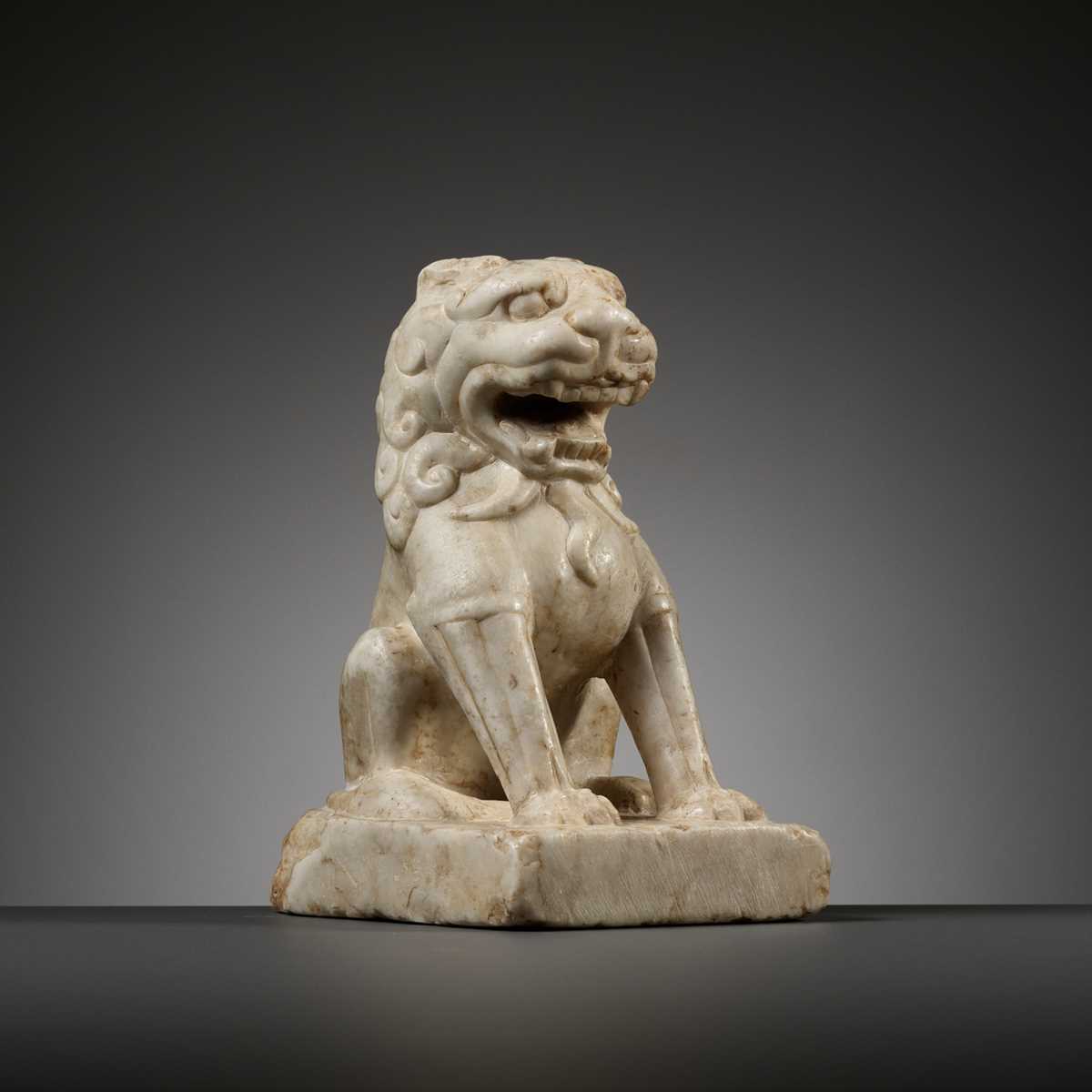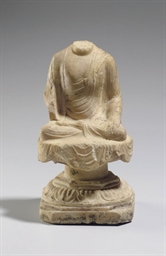Lot details Published: Religion and Ritual, Michael B. Weisbrod, Inc., 1987, no. 19. China, 618-907. Finely carved, the beast seated on its haunches atop a rectangular plinth and facing forward with the mouth wide open in a ferocious roar, the fierce expression further marked by large bulging eyes. Three long strands of a split beard are smoothly carved on the chest below the chin in rounded relief. The pointed ears are laid back above the thick, subtly carved curls of the mane. Its tail curls around the figure’s right side with the end lying over the back paw and below the chest. Provenance: Michael B. Weisbrod, Inc., New York, USA, acquired 1985 in the Hong Kong market. The collection of J. Abraham Cohen, New York, USA, acquired from the above. Michael B. Weisbrod, Inc., New York, USA, 2010, acquired from the above. A notable Canadian private collection, acquired from the above. Michael B. Weisbrod is a noted scholar of Chinese art, who has published extensively on the subject over a time span of more than 50 years. In 1972, Michael joined his father Dr. Gerald Weisbrod’s Asian art gallery in Toronto, Canada. The father-and-son team opened their New York location on Madison Avenue in 1977, and during the next 45 years the gallery held a significant number of exhibitions, selling to museums and private collectors across the globe, eventually adding further locations in Shanghai and Hong Kong. Condition: Superb condition, commensurate with age. Small losses and nicks, light scratches, old wear and weathering, some imperfections to the stone. Fine, naturally grown patina with an unctuous feel and a magnificent ivory color overall. Weight: 1,837 g Dimensions: Height 16.2 cm The lion is well represented in Buddhist art of the Tang dynasty. Its roar was said to represent the dissemination of the Buddhist scriptures. In their role as guardian figures, lions can be found not only lining spirit roads which lead to imperial tombs, but also in pairs in tombs, such as the pair of small marble lions found guarding the front room of the underground hoard of Buddhist relics at the Famen Temple. See Famen Temple, Shanxi, 1990, pp. 164-167. This figure is stylistically related to other marble lions of Tang date that are also seated on a plinth, some facing forward, some with the mouth open. Literature comparison: The present marble lion bears a strong resemblance to one of the large stone guardian lions along the spirit path of the Qian Ling mausoleum, the tomb of Emperor Gao Zong and Empress Wu Zetian near Xi’an, illustrated by Qian, Out of China’s Earth, page 156, and also by Siren, Chinese Sculpture from the Fifth to the Fourteenth Century, volume 4, pl. 431A. Allowing the difference in size and material, there is a marked similarity in the shape of the muzzle, the split beard and the collar of flesh between the shoulders and legs. The large stone lion is probably no later than AD 683, the year of Gao Zong’s death. Auction result comparison: Type: Closely related Auction: Christie’s New York, 24 September 2020, lot 908 Price: USD 475,000 or approx. EUR 533,500 converted and adjusted for inflation at the time of writing Description: A small white marble figure of a seated lion, China, Tang dynasty Expert remark: Compare the closely related pose, roar, split beard, bulging eyes, and plinth. Note the similar size (18.2 cm). Auction result comparison: Type: Closely related Auction: Christie’s New York, 25 March 2022, lot 742 Price: USD 75,600 or approx. EUR 74,000 converted at the time of writing Description: A superb carved white marble figure of a lion, Tang dynasty Expert remark: Compare the closely related pose, roar, split beard, bulging eyes, and plinth. Note the similar size (17 cm). 唐代小漢白玉獅 中國,618-907年。雕工精巧,石獅呈現蹲坐式樣,前肢斜伸,胸部挺起,獅頭昂揚,雙目圓睜,頭頸處鬃毛分成數縷垂捲,細膩逼真,體格雄健。它的尾巴捲曲在右側,末端位於後爪上方和胸部下方。 出版:Michael B. Weisbrod,Inc.,《Religion and Ritual》,1987年,編號19。 來源:美國Michael B. Weisbrod藝廊,1985年購於香港;美國紐約J. Abraham Cohen收藏;B. Weisbrod藝廊2010年購於上述收藏。美國紐約Mich
Lot details Published: Religion and Ritual, Michael B. Weisbrod, Inc., 1987, no. 19. China, 618-907. Finely carved, the beast seated on its haunches atop a rectangular plinth and facing forward with the mouth wide open in a ferocious roar, the fierce expression further marked by large bulging eyes. Three long strands of a split beard are smoothly carved on the chest below the chin in rounded relief. The pointed ears are laid back above the thick, subtly carved curls of the mane. Its tail curls around the figure’s right side with the end lying over the back paw and below the chest. Provenance: Michael B. Weisbrod, Inc., New York, USA, acquired 1985 in the Hong Kong market. The collection of J. Abraham Cohen, New York, USA, acquired from the above. Michael B. Weisbrod, Inc., New York, USA, 2010, acquired from the above. A notable Canadian private collection, acquired from the above. Michael B. Weisbrod is a noted scholar of Chinese art, who has published extensively on the subject over a time span of more than 50 years. In 1972, Michael joined his father Dr. Gerald Weisbrod’s Asian art gallery in Toronto, Canada. The father-and-son team opened their New York location on Madison Avenue in 1977, and during the next 45 years the gallery held a significant number of exhibitions, selling to museums and private collectors across the globe, eventually adding further locations in Shanghai and Hong Kong. Condition: Superb condition, commensurate with age. Small losses and nicks, light scratches, old wear and weathering, some imperfections to the stone. Fine, naturally grown patina with an unctuous feel and a magnificent ivory color overall. Weight: 1,837 g Dimensions: Height 16.2 cm The lion is well represented in Buddhist art of the Tang dynasty. Its roar was said to represent the dissemination of the Buddhist scriptures. In their role as guardian figures, lions can be found not only lining spirit roads which lead to imperial tombs, but also in pairs in tombs, such as the pair of small marble lions found guarding the front room of the underground hoard of Buddhist relics at the Famen Temple. See Famen Temple, Shanxi, 1990, pp. 164-167. This figure is stylistically related to other marble lions of Tang date that are also seated on a plinth, some facing forward, some with the mouth open. Literature comparison: The present marble lion bears a strong resemblance to one of the large stone guardian lions along the spirit path of the Qian Ling mausoleum, the tomb of Emperor Gao Zong and Empress Wu Zetian near Xi’an, illustrated by Qian, Out of China’s Earth, page 156, and also by Siren, Chinese Sculpture from the Fifth to the Fourteenth Century, volume 4, pl. 431A. Allowing the difference in size and material, there is a marked similarity in the shape of the muzzle, the split beard and the collar of flesh between the shoulders and legs. The large stone lion is probably no later than AD 683, the year of Gao Zong’s death. Auction result comparison: Type: Closely related Auction: Christie’s New York, 24 September 2020, lot 908 Price: USD 475,000 or approx. EUR 533,500 converted and adjusted for inflation at the time of writing Description: A small white marble figure of a seated lion, China, Tang dynasty Expert remark: Compare the closely related pose, roar, split beard, bulging eyes, and plinth. Note the similar size (18.2 cm). Auction result comparison: Type: Closely related Auction: Christie’s New York, 25 March 2022, lot 742 Price: USD 75,600 or approx. EUR 74,000 converted at the time of writing Description: A superb carved white marble figure of a lion, Tang dynasty Expert remark: Compare the closely related pose, roar, split beard, bulging eyes, and plinth. Note the similar size (17 cm). 唐代小漢白玉獅 中國,618-907年。雕工精巧,石獅呈現蹲坐式樣,前肢斜伸,胸部挺起,獅頭昂揚,雙目圓睜,頭頸處鬃毛分成數縷垂捲,細膩逼真,體格雄健。它的尾巴捲曲在右側,末端位於後爪上方和胸部下方。 出版:Michael B. Weisbrod,Inc.,《Religion and Ritual》,1987年,編號19。 來源:美國Michael B. Weisbrod藝廊,1985年購於香港;美國紐約J. Abraham Cohen收藏;B. Weisbrod藝廊2010年購於上述收藏。美國紐約Mich














Testen Sie LotSearch und seine Premium-Features 7 Tage - ohne Kosten!
Lassen Sie sich automatisch über neue Objekte in kommenden Auktionen benachrichtigen.
Suchauftrag anlegen